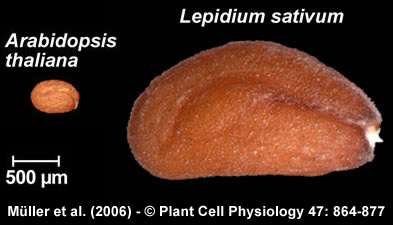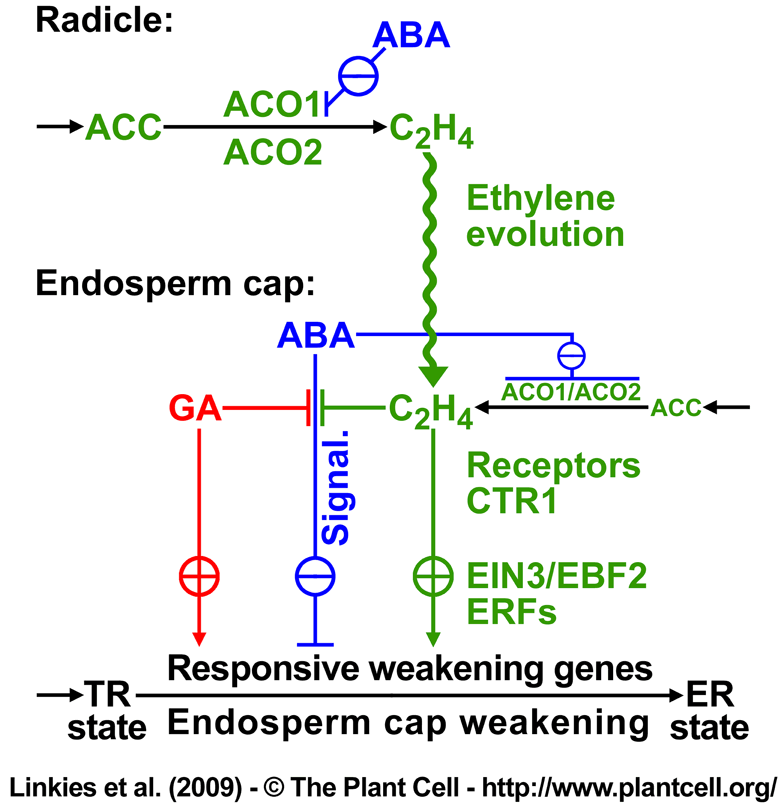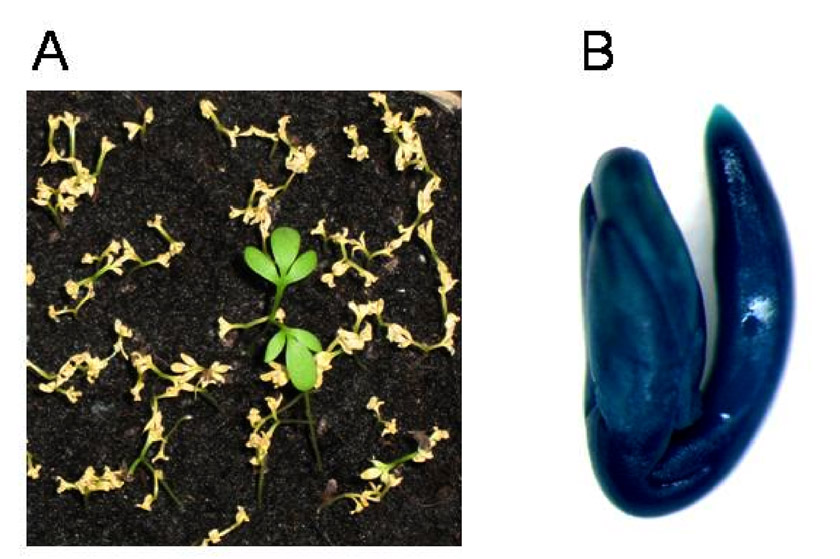Dr. Ada Linkies, Dipl.-Ing. Gartenbau (FH)
Postdoctoral researcher
DFG project Brassicaceae
endosperm weakening
Email: ada.linkies@biologie.uni-freiburg.de
Phone: ++49-761-203-2669 (office group Leubner)
Phone: ++49-761-203-2808 (lab)
Research interests:
- Seed biology, basic research and applied aspects
- Seed germination, its hormonal regulation and the interactions between seed tissues
- Stress physiology of seed germination and seedling establishment
- Cross-species approaches that include model and horticultural/agricultural crop plants
- Seed evolution and environmental adaptation
Academic career
Publications and
presentations at conferences
My postdoc project: Seed germination of endospermic Brassicaceae
My PhD project: Ethylene-ABA regulation of Brassicaceae endosperm weakening
 |
 |
 
|
 |
| |
|
My postdoc project: Molecular physiology of endosperm-limited seed germination - Gene function and regulation in the endosperm of Brassicaceae species
Project summary (DFG LE720/6-3): We have shown by cross-species work with Lepidium sativum (Lepidium, big seeds) and Arabidopsis that endosperm weakening is an important trait of these Brassicaceae species. We have used seed-tissue-specific transcriptome analysis, genetic transformation, qRT-PCR, germination physiology, cell-wall biochemistry, reverse-genetics, and biomechanics to establish Lepidium as a model system for interdisciplinary seed research. Our new work plan includes as goals to identify and analyse tissue-specific promoters for reverse-genetics and superior house-keeping genes for qRT-PCR for seed research by utilizing our seed-tissue-specific transcriptome. This project aims to deliver transgenic seeds altered in upstream and downstream mechanisms of endosperm weakening for functional and biomechanical analysis and will provide novel insight into endosperm function during seed germination.
People (DFG LE720/6-3): Dr. Ada Linkies as postdoc, Antje Voegele and Magdalena Jura as PhD students.
|
|
My PhD project: A comparative Brassicaceae approach with Lepidium sativum and Arabidopsis thaliana to investigate mechanisms of seed germination and endosperm weakening
Project background:
In mature seeds of most angiosperm species the embryo is covered by a more or less abundant layer of endosperm tissue, which is surrounded by the seed coat (testa). Direct and indirect evidence supports a mechanistic model in that the micropylar part of the endosperm (endosperm cap), which covers the radicle of the embryo, is involved in the regulation of the germination process by functioning as a barrier for radicle protrusion through the covering layers. It has been shown for several species that during germination the endosperm cap weakens until the radicle is able to rupture the surrounding tissues, which defines the completion of germination. Abscisic acid (ABA) as germination inhibiting hormone is well characterized in his mode of action, while the action of ethylene, which has been described as germination promoting hormone was not very clear prior to my Ph.D. work.
Title of my Ph.D. Thesis (Ada Linkies, 2010) and information about my Ph.D. work:
"A comparative Brassicaceae approach with Lepidium sativum and Arabidopsis thaliana to investigate mechanisms of seed germination and endosperm weakening"
Grade: magna cum laude (very good), Ph.D. work 01.2006-03.2010, lab of G. Leubner in Freiburg, financed by DFG LE720/6
|
|
Major findings and conclusions of my Ph.D. work:
In a comparative approach of the closely related Brassicaceae species Arabidopsis thaliana and Lepidium sativum (garden cress) we have shown how ethylene controls seed germination, that an ethylene-ABA antagonism is evident, and that interactions between seed tissues take place during germination (Linkies et al., 2009). The larger seed size of L. sativum allows the direct biomechanical determination of endosperm weakening by puncture force measurements and facilitates the investigation of specific seed tissues (see web page Kerstin Müller).
For further details on these seed model systems see the "Seed structure" and "Endosperm weakening" webpages and the Müller et al. (2006) publication.
|
 |

|
These advantages were utilized, together with its close relatedness to Arabidopsis, to carry out cross-species heterologous transcriptome analyses with L. sativum radicle and endosperm tissues, sampled at different times during germination. We have shown that ethylene promotes endosperm weakening of L. sativum and that it promotes endosperm rupture and counteracts the inhibiting effect of ABA in both L. sativum and A. thaliana. The reversion of the ABA-mediated inhibition by ethylene is achieved via ABA signaling and not via effects on ABA biosynthesis. The impact of ethylene on seed germination is dependent both on its biosynthesis, which in seeds is mainly regulated by ACC oxidase (ACO), and on downstream signaling. Ethylene signaling involves tissue interactions between radicle and endosperm to mediate endosperm weakening and rupture.
The comparative approach with L. sativum and A. thaliana led to the conclusion that the action of and interaction between ethylene and ABA constitutes a conserved mechanism among the Brassicaceae. The ACO2 orthologues of several Brassicaceae appear to play a cross-species key role in seed germination.
The synopsis of our detailed analysis is summarized as a model (see image on the right), showing tissue and hormone interactions leading to endosperm weakening and rupture. The results of this approach have led to a publication in The Plant Cell (Linkies et al., 2009).
For my publications and presentations at conferences: See list below.
|
 |

|
We further exploited the bigger seed size of L. sativum to construct an endosperm-specific suppression subtractive hybridization (SSH) library containing transcripts that are up-regulated late during the germination process in the endosperm cap of seeds of L. sativum. Sequence analysis revealed that a number of genes known to be up-regulated late during germination are up-regulated in the endosperm cap. We have shown in a detailed analysis of the germination kinetics of corresponding A. thaliana knock-out mutants that carried insertions in genes that were present in our library that the identified transcripts indeed play roles during germination. Among the transcripts in our library up-regulated late during germination and having a germination-specific phenoptype were the orthologues of three Arabidopsis peroxidases. Detailed transcript expression analyses by quantitative (real-time) PCR in specific L. sativum seed tissues in the presence and absence of ABA showed tissue-specific regulation. Also the peroxidase activity and particularly its regulation by ABA differed between endosperm cap and radicle. The outcome of the SSH approach has resulted in a publication in the Journal of Experimental Botany (Linkies et al. 2010).
During my Ph.D. work I was significantly involved in the establishment of L. sativum as a model species. This is based on its close phylogenetic relationship to the model plant A. thaliana, including high sequence similarities and therefore easy cloning and analysis of gene sequences from L. sativum, combined with the possibility of single-seed-tissue analyses on molecular, biochemical and biomechanical level. Further the plant can be easily propagated and is transformable by using the floral-dip method (see images below).

Reverse-genetics of Lepidium sativum (Ada Linkies, unpublished)
A: Transgenic seedling of L. sativum after herbicide selection
B: Transgenic embryo of L. sativum harbouring a promoter:GUS-fusion construct
|
|


| |
Academic career |
 |
|
|
 |
 |
 |
Since March 2010
 |
|
Postdoc in the DFG project "Endosperm weakening" (DFG LE720/6) in Gerhard Leubner’s seed biology lab at the Faculty of Biology, Albert-Ludwigs-University, Freiburg, Germany.
 |
04.2009
 |
 |
Research visit at the Université Pierre et Marie Curie, Paris, France (lab of Prof. Françoise Corbineau)
 |
Since 2008
 |
 |
Member of the ISSS (International Seed Science Society)
 |
01.2006 - 03.2010
 |
 |
Ph.D. work in Seed Biology: Thesis "A comparative Brassicaceae approach with Lepidium sativum and Arabidopsis thaliana to investigate mechanisms of seed germination and endosperm weakening" at the Faculty of Biology, Albert-Ludwigs-University, Freiburg, Germany. Supervisor: PD Dr. Gerhard Leubner. Grade: magna cum laude (very good)
 |
03.2004 - 07.2005
 |
 |
Traineeship at Genetwister Technologies B.V. (The Netherlands): Identification of marker genes for the determination of fruit ripening
 |
09.2001 - 09.2003
 |
 |
Study and MSc work in Biotechnology: Wageningen University (The Netherlands). English spoken Master of Science course Biotechnology. Thesis subject: "Investigation about function and localisation of SKI-1, a putative subtilase in plants". Grade: A- (good)
 |
03.2000 - 12.2000
 |
 |
Employment as technical researcher at Research Station for Nursery Stock, Boskoop (The Netherlands); field trials regarding pathogen susceptibility of horticultural crops.
 |
04.1999 - 07.1999
 |
 |
Internship at Versuchs- und Beratungsring Baumschulen e.V., Pinneberg (Germany); participation in field trials with different horticultural crops
 |
04.1998 - 08.1998
 |
 |
Internship at GAB Biotechnologie GmbH, Pforzheim (Germany); participation in field trials regarding pesticide residues and efficiency
 |
07.1997 - 08.1997
 |
 |
Temporary work at Research Station Geisenheim (Germany); participation in field trials with horticultural crops
 |
09.1995 - 12.1999
 |
 |
Study and BSc work in Horticulture: Fachhochschule Wiesbaden (Germany). Bachelor of Science course Horticulture (Gartenbau). Thesis subject: "Determination of infestation with Phytophthora spp. of irrigation ponds used by nurseries". Grade: 1 (very good)
 |
 |
 |
|
|
|


| |
Publications and
presentations at conferences |
 |
|
|
Peer-reviewed publications
Linkies A*, Leubner-Metzger G (2012)
Beyond gibberellins and abscisic acid: how ethylene and jasmonates control seed germination
Plant Cell Reports 31: 253-270 *corresponding author
Graeber K, Linkies A, Wood ATA, Leubner-Metzger G (2011)
A guideline to family-wide comparative state-of-the-art quantitative RT-PCR analysis exemplified with a Brassicaceae cross-species seed germination case study
The Plant Cell 23: 2045-2063
Rentzsch S, Podzimska D, Voegele A, Imbeck M, Müller K, Linkies A*, Leubner-Metzger G* (2012)
Dose- and tissue-specific interaction of monoterpenes with the gibberellin-mediated release of potato tuber bud dormancy, sprout growth and induction of α-amylases and β-amylases
Planta 235: 137-151 *shared corresponding authors
Voegele A, Linkies A, Müller K, Leubner-Metzger G (2011)
Members of the gibberellin receptor gene family GID1 (GIBBERELLIN INSENSITIVE DWARF1) play distinct roles during Lepidium sativum and Arabidopsis thaliana seed germination
Journal of Experimental Botany 62: 5131–5147
Morris K, Linkies A, Müller K, Oracz K, Wang X, Lynn JR, Leubner-Metzger G, Finch-Savage WE (2011)
Regulation of seed germination in the close Arabidopsis relative Lepidium sativum: A global tissue specific transcript analysis
Plant Physiology 155: 1851-1870
Linkies A, Graeber K, Knight C, Leubner-Metzger G (2010)
The evolution of seeds.
Tansley review. New Phytologist 186: 817-831
Graeber K, Linkies A, Müller K, Wunchova A, Rott A, Leubner-Metzger G (2010)
Cross-species approaches to seed dormancy and germination: Conservation and biodiversity of ABA-regulated mechanisms and the Brassicaceae DOG1 genes.
Plant Molecular Biology 73: 67-87
Linkies A, Müller K, Morris K, Tureckova V, Wenk M, Cadman CSC, Corbineau F, Strnad M, Lynn JR, Finch-Savage WE, Leubner-Metzger G (2009)
Ethylene interacts with abscisic acid to regulate endosperm rupture during germination; a comparative approach using Lepidium sativum (cress) and Arabidopsis thaliana.
The Plant Cell 21: 3803-3822
Linkies A, Schuster-Sherpa U, Tintelnot S, Leubner-Metzger G, Müller K (2010)
Peroxidases identified in a substractive cDNA library approach show tissue-specific
transcript abundance and enzyme activity during seed germination of Lepidium sativum.
Journal of Experimental Botany 61: 491-502
Müller K, Carstens AC, Linkies A, Torres MA, Leubner-Metzger G (2009)
The NADPH-oxidase AtrbohB plays a role in Arabidopsis seed after-ripening.
New Phytologist 184: 885-897
Müller K, Linkies A, Vreeburg RAM, Fry SC, Krieger-Liszkay A, Leubner-Metzger G (2009)
In vivo cell wall loosening by hydroxyl radicals during cress seed germination and elongation growth.
Plant Physiology 150: 1855-1865
Hermann K, Meinhard J, Dobrev P, Linkies A, Pesek B, Heß B, Machácková I, Fischer U,
Leubner-Metzger G (2007)
The control of sugar beet (Beta vulgaris L.) germination
by plant hormones – a comparative study of fruits and seeds.
Journal of Experimental Botany
58: 3047-3060
Poster presentations
15th Crucifer Genetics Workshop: Brassica 2006, Wageningen, Netherlands, October 2006:
"Gene function and regulation in the endosperm of Lepidium sativum and Arabidopsis thaliana."
Oral presentations
Botanikertagung 'Diversity makes the difference', September 2011, Berlin, Germany. Workshop 'Seed Biology, together with Gerhard Leubner:
"Multilevel cross-species approaches to identify evolutionary conserved and diverse mechanisms that control seed dormancy and germination"
3rd ISSS Workshop on the Molecular Aspects of Seed Dormancy and Germination, York, UK, July 2010:
"Superior housekeeping genes for state-of-the-art qPCR normalization during seed germination obtained by tissue-specific transcriptome analysis and cross-species comparison"
29th ISTA (International Seed Testing Association) congress, Köln, June 2010:
"The combined use of Arabidopsis thaliana and Lepidium sativum to find conserved mechanisms of seed germination within the Brassicaceae family"
SEST 09: International symposium on seed, transplant and stand establishment, Murcia, Spain, September 2009:
"A combined approach with the brassicaceae species Arabidopsis thaliana and Lepidium sativum to identify key genes controlling seed germination"
Millennium Seed Bank science and conservation seminar series, Kew Gardens, UK, May 2009:
"Dormancy and germination of the endospermic seeds of Arabidopsis thalina and Lepidum sativum (garden cress)"
22. Tagung Molekularbiologie der Pflanzen, Dabringhausen, Germany, February 2009:
"Vergleichende Samenbiologie: Molekulare Mechanismen des endosperm weakenings bei Brassicaceaen"
9th ISSS conference on seed biology, Olsztyn, Poland, July 2008:
"A reverse genetics approach to endosperm weakening by using Brassicaceae relatives"
|
|
| |
 |
|
|
| |
 |
|
|
|
|
 |
| |
|
|
|

|


 |

